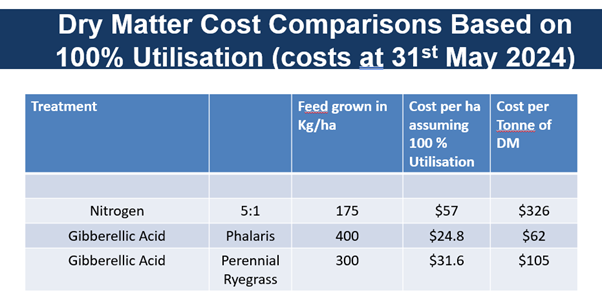Stock Journal Feature - August 2024
Author: Andrew Spiers, Meridian Agriculture
During seasonal challenges with a very late break and forage becoming more expensive and harder to find, we need to explore other means to fill the feed gap. Two options often considered are the use of either Gibberellic Acid (GA) or Urea to increase the amount of available dry matter produced.
Gibberellic acid is a naturally occurring plant hormone, its mode of action is to mobilise stored carbohydrates within the plant to push that into growing material resulting in bigger cells with increased carbohydrate content. CSIRO trials on pasture illustrated a response of about 500kg of DM/ha on a Phalaris based pasture by applying 4 grams of actual Gibberellic Acid per hectare. During winter, a perennial grass’ natural ability to produce gibberellic acid is low, so supporting them by applying Gibberellic Acid enhances the dry matter produced.
There are some conditions that need to be met for GA to work effectively:
- Ambient temperature needs to be less than 15 degrees Celsius, soil nutrition non limiting and adequate moisture so plants can grow.
- Pasture needs to contain responsive perennial plants (i.e. Phalaris, cocksfoot or perennial ryegrass – it doesn’t work on fescues). They need to be at least second year pastures, as newly sown pastures don’t have an established root mass and therefore lack the stored carbohydrates needed to be mobilised for growth.
- Annual grasses and cereals etc had very limited responses to gibberellic acid in trials. If the plants had been sown early (i.e. February) and have been able to establish a root mass, there are some demonstrations giving a GA response on these plants. However annual ryegrass’ and cereals sown post March do not respond to Gibberellic Acid.
- Gibberellic Acid is a foliar spray and is absorbed by the leaf of the plant only, therefore you need to have close to 80 – 90% groundcover. Any GA that lands on the soil won’t be taken up by the plant roots, and neither will any that is washed off leaves due to a quick rain event.
- Need to allow two hours drying time post application, to ensure GA has been taken up by the plant.
- Withholding the paddock from grazing for 21 days gives the best dry matter response as it allows the plant cells to expand and capture more sunlight to aid in photosynthesis.
- Be aware that the extra dry matter grown in winter following GA application, is feed that’s foregone from mid to late spring production, not lost, just shifting it to where you need it.
Similar to Gibberellic Acid, Urea (Nitrogen) works best when there is adequate fertility, soil moisture, leaf area, and with a perennial grass base. However, soil temperatures need to be above 12 degrees Celsius, and more available sunlight is needed for best responses. In the winter period responses to nitrogen is slow and the rate of response per kilogram of nitrogen is low.
Pastures that are strongly nitrogen responsive will have strong growth of the grass component of the sward with both a deeper green and increased dry matter visible, but as discussed, in winter these responses are very slow.
We recently conducted a cost comparison taking into account product applied and application costs, see Table 1, we found not only that the cost per tonne of dry matter produced varied significantly, but that also when the response time to grazing was 21 days for GA versus between 36 and 90 days for the Urea, the use of Gibberellic Acid was the least expensive per tonne of dry matter produced.
Table 1:

From late May onwards, nitrogen is less effective than Gibberellic Acid, until the daylight hours extend, and the soil temperatures rise.
No known impact on the persistence of the treated pastures providing management and soil nutrition is adequate with the use of Gibberellic Acid.
In conclusion, Gibberellic Acid is more effective through June, July, August and Nitrogen is more effective April May and from late August onwards.





